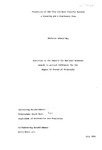Prediction of the Flow and Heat Transfer between a Rotating and a Stationary Cone
| dc.contributor.author | May, Nicholas Edward | |
| dc.contributor.other | School of Engineering, Computing and Mathematics | en_US |
| dc.date.accessioned | 2013-02-08T10:14:08Z | |
| dc.date.accessioned | 2012-08-02T08:10:27Z | |
| dc.date.available | 2013-02-08T10:14:08Z | |
| dc.date.available | 2012-08-02T08:10:27Z | |
| dc.date.issued | 1990-07 | |
| dc.date.issued | 1990-07 | |
| dc.identifier | N/A | en_US |
| dc.identifier.uri | http://hdl.handle.net/10026.1/1276 | |
| dc.description | Access to the full-text thesis is no longer available at the author's request, due to 3rd party copyright restrictions. Access removed on 28.11.2016 by CS (TIS). | |
| dc.description | Metadata merged with duplicate record (http://hdl.handle.net/10026.1/1069) on 20.12.2016 by CS (TIS). | |
| dc.description.abstract |
This thesis is concerned with the development of a theoretical method for predicting the turbulent flow and heat transfer in the cavity between a rotating and a stationary cone. The motivation for the work stems from the need, in the design process for the gas turbine aero-engine, for a fast and reliable predictive method for such flows. The method developed here is the integral method, which reduces the governing partial differential equations to ordinary differential equations. A number of solution methods for these equations are described, and the optimum in terms of speed and accuracy is indicated. Predicted moment coefficients compare well with experimental data. For half-cone angles greater than approximately 60° but poorly for half cone angle less than approximately 45°. The poor agreement for small cone angles is thought to be due to the presence of Taylor-type vortices, which cannot be incorporated into the integral method. Heat transfer is incorporated into the method using the Reynolds analogy. Due to the lack of experimental data, heat transfer predictions are compared with those from a finite difference program and show encouraging agreement. A computer program which solves the full Reynolds-averaged Navier-Stokes and energy equations in steady and axisymmetric form, using a finite-difference method is modified for use in the conical geometry. Comparison of the predicted moment coefficients with experimental data shows no marked improvement over the integral method. Examination of the secondary flow predicted by the program shows it to be similar to that of the integral method. The failure of the program to predict Taylor-type vortices may be attributed to the fact that they are non-axisymmetric and/or unsteady. The assumptions underlying the Integral method are investigated via the finite difference program and it is concluded that they are valid for half cone angles as small as 15°. Based on the results of the finite difference program, the Integral method is modified to allow for a rectangular outer shroud, and a new model for the stator is described. It is concluded that both the integral method and the finite difference program can be used safely in rotor-stator systems where the half cone angle is greater than about 60°. | en_US |
| dc.description.sponsorship | Rolls-Royce plc | en_US |
| dc.language.iso | en | en_US |
| dc.publisher | University of Plymouth | en_US |
| dc.title | Prediction of the Flow and Heat Transfer between a Rotating and a Stationary Cone | en_US |
| dc.type | Thesis | |
| plymouth.version | Full version | en_US |
| dc.identifier.doi | http://dx.doi.org/10.24382/3841 |
Files in this item
This item appears in the following Collection(s)
-
01 Research Theses Main Collection
Research Theses Main


